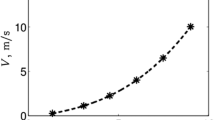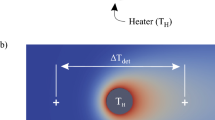Abstract
A correction method, based on experimental results, has been developed to remedy the amplitude attenuation that occurs when statically calibrated hot-film shear stress sensors are used in air. The correction method is necessary in applications where typically two-dimensional arrays of measurement points are needed and other sensors, such as hot wires, cannot be employed. The method was developed with a primary aim of obtaining the correct power spectral density of an ensemble-averaged signature from an array of hot-film shear stress sensors. The hot-film sensors are corrected by comparing their individual power spectral densities to a reference spectrum obtained with a single hot wire, slightly elevated but within the viscous sublayer of the turbulent boundary layer. The method is verified by comparing the corrected hot film’s turbulence statistics, power spectral density, and correlation coefficients with the corresponding results from the hot wire.
Similar content being viewed by others
References
Alfredsson PH, Johansson AV, Haritonidis JH, Eckelmann H (1988) The fluctuating wall-shear stress and the velocity field in the viscous sublayer. Phys Fluids 31:1026–1033
Bellhouse BJ, Schultz DL (1967) The determination of fluctuating velocity in air with heated thin-film gauges. J Fluid Mech 29:289–295
Bellhouse BJ, Schultz DL (1968) The measurement of fluctuating skin friction in air with heated thin-film gauges. J Fluid Mech 32:675–680
Breuer KS (1995) Stochastic calibration of sensors in turbulent flow fields. Exp Fluids 19:138–141
Brown GL, Thomas ASW (1977) Large structure in a turbulent boundary layer. Phys Fluids 20:S243-S252
Bruun HH (1995) Hot-wire anemometry. Oxford University Press, Oxford
Chew YT, Khoo BC, Li GL (1998) An investigation of wall effects on hot-wire measurements using a bent sublayer probe. Meas Sci Technol 9:67–85
Chew YT, Khoo BC, Lim CP, Teo CJ (1998) Dynamic response of a hot-wire anemometer. Part II: a flush-mounted hot-wire and hot-film probes for wall shear stress measurements. Meas Sci Technol 9:764–778
Chew YT, Shi SX, Khoo BC (1995) On the numerical near-wall corrections of single hot-wire measurements. Int J Heat Fluid Flow 16:471–476
Cook WJ (1994) Response of hot-element wall shear stress gages in unsteady turbulent flows. AIAA J 32:1464–1471
Cook WJ, Giddings TA, Murphy JD (1988) Response of hot-element wall shear stress gages in laminar oscillating flows. AIAA 26:706–713
Khoo BC, Chew YT, Li GL (1997) Effects of imperfect spatial resolution on turbulence measurements in the very near-wall viscous sublayer region. Exp Fluids 22:327–335
Khoo BC, Chew YT, Lim CP, Teo CJ (1998) Dynamic response of a hot-wire anemometer. Part I: a marginally elevated hot-wire probe for near-wall velocity measurements. Meas Sci Technol 9:751–763
Khoo BC, Chew YT, Teo CJ, Lim CP (1999) The dynamic response of a hot-wire anemometer: III. voltage perturbation versus velocity perturbation testing for near-wall hot-wire/film probes. Meas Sci Technol 10:152–169
Kim J, Moin P, Moser R (1987) Turbulence statistics in fully developed channel flow at low Reynolds number. J Fluid Mech 177:133–166
Krishnamoorthy LV, Wood DH, Antonia RA, Chambers AJ (1985) Effect of wire diameter and overheat ratio near a conducting wall. Exp Fluids 3:121–127
Ligrani PM, Bradshaw P (1987) Spatial resolution and measurement of turbulence in the viscous sublayer using subminiature hot-wire probes. Exp Fluids 5:407–417
Ljus C, Johansson B, Almstedt A-E (2000) Frequency response correction of hot-film measurements in a turbulent airflow. Exp Fluids 29:36–41
Marusic I, Kunkel GJ, Porte-Agel F (2001) Experimental study of wall boundary conditions for large-eddy simulation. J Fluid Mech 446:309–320
Moen MJ, Schneider SP (1994) The effect of sensor size on the performance of flush-mounted hot-film sensors. J Fluids Eng 116:273–277
Rajagopalan S, Antonia RA (1979) Some properties of the large structure in a fully developed turbulent duct flow. Phys Fluids 22:614–622
Uddin AKM, Perry AE, Marusic I (1997) On the validity of Taylor’s hypothesis in wall turbulence. J Mech Eng Res Dev 19/20: 57–66
Author information
Authors and Affiliations
Corresponding author
Additional information
Published online: 19 December 2002
Rights and permissions
About this article
Cite this article
Kunkel, G.J., Marusic, I. An approximate amplitude attenuation correction for hot-film shear stress sensors. Experiments in Fluids 34, 285–290 (2003). https://doi.org/10.1007/s00348-002-0558-9
Received:
Accepted:
Issue Date:
DOI: https://doi.org/10.1007/s00348-002-0558-9




